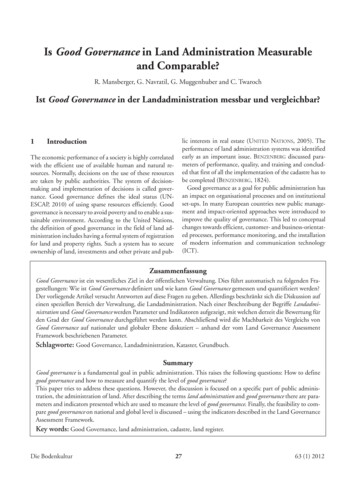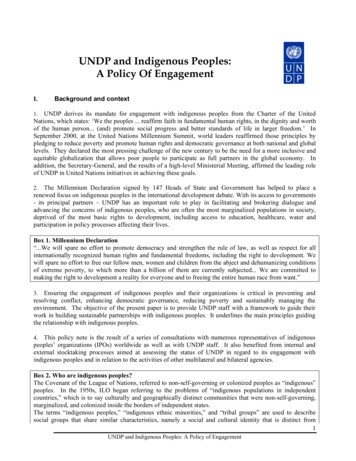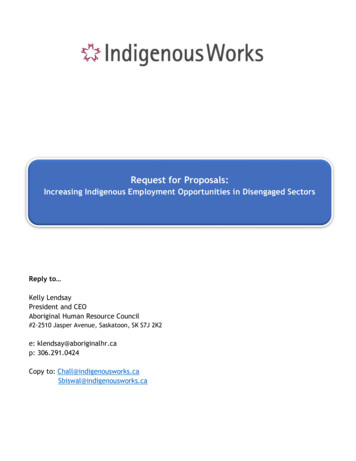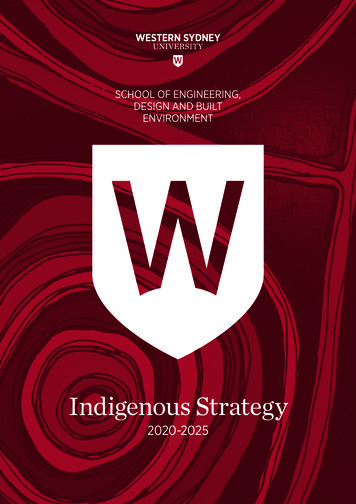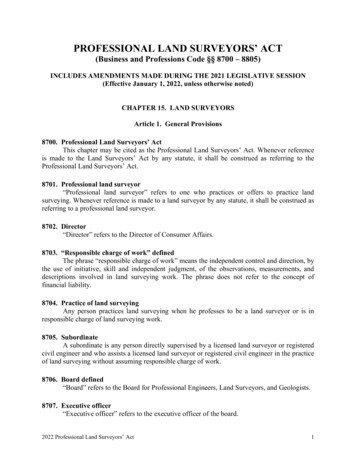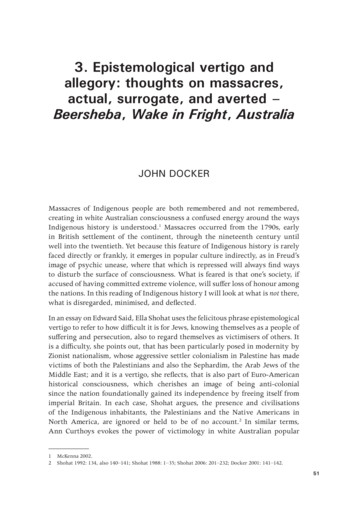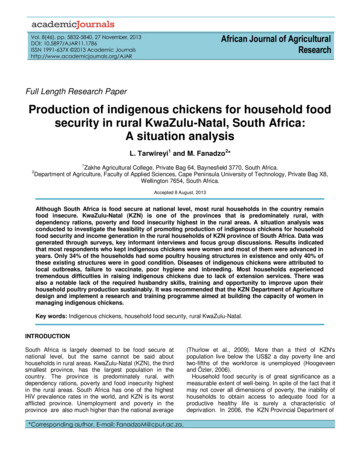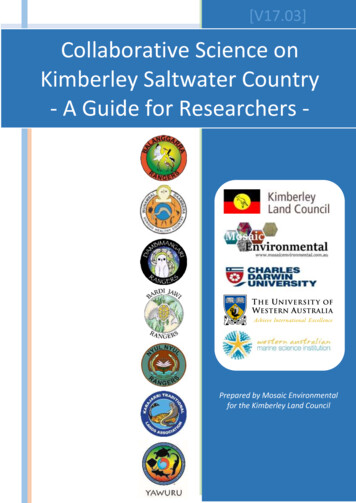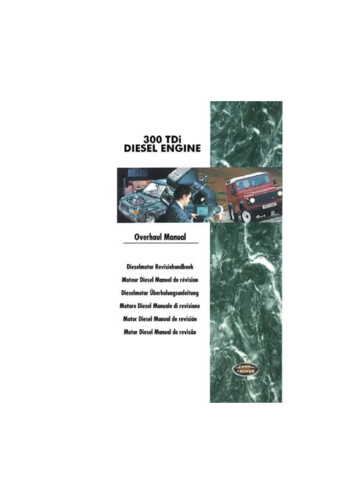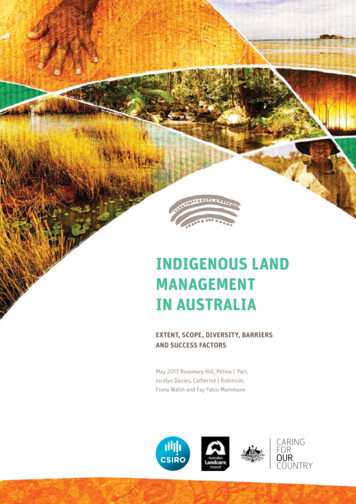
Transcription
INDIGENOUS LANDMANAGEMENTIN AUSTRALIAEXTENT, SCOPE, DIVERSITY, BARRIERSAND SUCCESS FACTORSMay 2013 Rosemary Hill, Petina L Pert,Jocelyn Davies, Catherine J Robinson,Fiona Walsh and Fay Falco-Mammone
ISBNABOUT THIS REPORTIMPORTANT DISCLAIMERARTWORK978-1-922173-94-2 PRINT978-1-922173-95-9 ONLINEThis report was prepared byCSIRO in response to termsof reference prepared by theAustralian Landcare Council’sIndigenous Working Group.It was funded by theAustralian Government’sCaring for our Countryinitiative through theDepartment of Agriculture,Fisheries and ForestryCSIRO advises that theinformation contained inthis publication comprisesgeneral statements based onscientific research. The readeris advised and needs to beaware that such informationmay be incomplete or unableto be used in any specificsituation. No reliance oractions must therefore bemade on that informationwithout seeking prior expertprofessional, scientific andtechnical advice. To the extentpermitted by law, CSIRO(including its employeesand consultants) excludesall liability to any person forany consequences, includingbut not limited to all losses,damages, costs, expensesand any other compensation,arising directly or indirectlyfrom using this publication(in part or in whole) andany information or materialcontained in it.Front cover design and artisticelements by Gilimbaawww.gilimbaa.com.auCSIRO ECOSYSTEM SCIENCES,SOCIAL AND ECONOMICSCIENCES PROGRAMBuilding Resilient AustralianBiodiversity Assets ThemeCITATIONHill, R., P.L. Pert, J. Davies,C.J. Robinson, F. Walsh, andF. Falco-Mammone (2013)Indigenous Land Managementin Australia: Extent, scope,diversity, barriers andsuccess factors. Cairns: CSIROEcosystem Sciences.COPYRIGHT AND DISCLAIMER 2013 CSIRO To the extentpermitted by law, all rightsare reserved and no part ofthis publication covered bycopyright may be reproducedor copied in any form or byany means except with thewritten permission of CSIRO.Cover images courtesy ofthe Australian Governmentdepartments of Agriculture,Fisheries and Forestry andSustainability, Environment,Water, Population andCommunities; Gilimbaa;Adam Liedloff; CSIRO Darwin;and finalists of the Workingon Country PhotographyCompetition 2012—JaneHodson and Jasmina Muhic.
Acronymsvi1Executive summary12Understanding Indigenous land management62.1What is Indigenous land management?62.2The cross-cultural context of Indigenous land management in Australia62.3Purpose of this report92.4Approach and methods92.5Drivers of Indigenous land management122.5.1Customary obligations to younger generations and country122.5.2Markets for land management and associated goods and services142.5.3Recognition of Indigenous rights and interests in land through6title and agreements162.5.4Movement towards Indigenous and co-managed conservation areas172.5.5Investments for indigenous engagement in improved environmentaland cultural heritage outcomes172.5.6Indigenous leadership at multiple levels of decision-making182.6State of Indigenous land management: scope, extent and diversity192.7Benefits associated with Indigenous land management293Success factors and barriers on the journey to best practice inIndigenous land management323.1Overview323.2Nine success factors and examples of the journey to best practice333.2.1Indigenous motivation333.2.2Indigenous governance and co-governance arrangements thatrespond to customary institutions363.2.3Hybrid economies383.2.4Indigenous-specific government programs that engage ilm throughmulti-year funding, real jobs and flexible case management403.2.5Brokers and brokering organisations433.2.6Relationships of trust, respect and mutuality453.2.7Diverse multimedia approaches for indigenous knowledge473.2.8Collaborative two-way knowledge engagement49iIndigenous Land Management in Australia
3.2.9Indigenous-driven planning (cultural, country based, comprehensive)513.3Barriers associated with Indigenous land management533.3.1Limited respect, recognition and practical support for Indigenousknowledge and world views53Limitations of native title, recognition of rights, and access totraditional lands and Waters533.3.3Limited resources for indigenous land management543.3.4Organisational and institutional capacity constraints553.3.5Socio-economic and educational disadvantage faced by Indigenouspeoples564Outlook for Indigenous land management584.1Optimism and realism584.2Potential for impact investment to improve the outlook forIndigenous land management58Land management policy settings for a positive ILM outlook583.3.24.3References61Appendix 1: Terms of reference73Appendix 2: Datasets74Appendix 3: Aboriginal motivations77Appendix 4: Chronology of key Indigenous land management events78Appendix 5: Best practice guidelines81Engaging Today, Building Tomorrow: A Framework for Engaging withAboriginal and Torres Strait Islander Australians81Guidelines for Ethical Research in Australian IndigenousStudies (GERAIS)81Protocol for Aboriginal Knowledge and Intellectual Property82Guidelines for Working with Indigenous Knowledge in NaturalResource Management82Guidelines for Indigenous Ecological Knowledge Management(including archiving and repatriation) and the Handbook for Workingwith Indigenous Ecological Knowledge & Intellectual Property82Guidelines for Indigenous Participation in Natural ResourceManagement83Our Country Our Way: Guidelines for Australian IndigenousProtected Area Management Plans83Ethical guidelines for commercial bush food research, industryand enterprises83ii
FiguresFigure 1 Australian Indigenous languages (Horton 1996)13Figure 2 Indigenous interests in country have been recognised tovarying extents over more than half of Australia20Figure 3 Indigenous land use agreements21Figure 4 Indigenous Protected Areas and Australia’s NationalReserve System21Figure 5 Indigenous Land Corporation land acquisition activity22Figure 6 Indigenous ranger groups funded through the AustralianGovernment’s Working on Country and Indigenous Protected Area programs22Figure 7 Investments in Indigenous projects on-country 2002-03 throughto 2011–1223Figure 8 Sites where Indigenous land management activities havebeen funded, 2002–1223Figure 9 Investment in Indigenous Land Management in Australia by investorportfolio, 2002–1224Figure 10 Investment in Indigenous land management in Australia by:(a) Australian Government conservation and land care programs; (b)Indigenous Land Corporation; (c) philanthropic organisations; and (d) otherprograms, 2002–1225Figure 11 Australian Government and philanthropic investment in stateand territory jurisdictions, 2002–1225Figure 12 Australian Government Indigenous-specific funding throughthe agriculture and environment portfolios, and total Australian GovernmentIndigenous-specific spending, 2000–01 to 2010–1128Figure 13 Proportion of Australian Government funding for environmentalmanagement allocated to Indigenous projects 1996-201228Figure 14 The hybrid economy, made up of three sectors (1, 2, and 3) andtheir interlinkages (4, 5, 6 and 7)iiiIndigenous Land Management in Australia38
TablesTable 1 Diverse components of Indigenous land management (based onDavies et al. 2010)7Table 2 Modified DPSIR framework to provide an analytical frameworksnapshot of Indigenous land management in Australia10Table 3 Health risk factors and moderators explaining positive impacts ofIndigenous land management on health in relevant research papers (n 17) thatwere identified through systematic review of ISI Web of Knowledge literature(international, all databases)30Table 4 Aboriginal motivations driving Indigenous land managementactivities (Davies et al.2010; Smyth et al. 2007)77Table 5 Chronology of key events relevant to the drivers of the contemporaryIndigenous land management, with an emphasis on South Australia andthe Northern Territory (Davies et al. 2010)78BoxesBox 1 Indigenous motivation and the best practice journey: Ikuntji (NT)and Wallis Lake (NSW)35Box 2 Indigenous governance and the best practice journey: Dhimurru(NT) and Girringun (QLD)37Box 3 Hybrid economies and the best practice journey: Fish River FireProject (NT) and ghost nets management (QLD, NT, WA)39Box 4 Well-designed Indigenous-specific programs and the best practicejourney: Indigenous Protected Areas and Working on Country (Australia-wide)42Box 5 Brokers and brokering organisations and the best practice journey:Central Land Council (NT) and regional natural resource management bodies(Australia-wide)44Box 6 Relationships and the best practice journey: desert raisin in centralAustralia (NT)46Box 7 Diverse multimedia approaches for Indigenous knowledge and the bestpractice journey: Indigenous ecological knowledge (NT) and the TraditionalKnowledge Revival Pathways (QLD, international)48Box 8 Collaborative two-way knowledge and the best practice journey:gubinge (WA) and Lake Condah Sustainable Development (VIC)50Box 9 Indigenous-driven planning and the best practice journey:Ngarrindjeri (SA)52iv
AcknowledgmentsWe would like to acknowledge and thankthe Australian Landcare Council and itsIndigenous Working Group (IWG) forsupporting this research, and for theirfine efforts in building cross-culturalunderstanding between the Landcareand Indigenous land managementmovements. In particular, weacknowledge and thank the IWG Chair,Kate Andrews, and members KeelenMailman and John McQuilten for theirwonderful contributions and input to thisstudy and report.The authors bring experience to thisproject from many other researchprojects that they have worked on overthe years. For their important roles insupporting this previous work, we thank: Indigenous organisations andcommunities throughout Australia Central Land Council (LC), KimberleyLC, Northern LC, Cape York LC Kanyirninpa Jukurrpa (Martu Archiveand Heritage Program) Murray Lower Darling RiversIndigenous Nations Northern Australian Indigenous Landand Sea Management Alliance South Australian Native Title Services Land & Water Australia Rural Industries Research andDevelopment Corporation Desert Knowledge CooperativeResearch Centre (CRC) Tropical Savannas CRC Rainforest CRC Northern Australia Waters FutureAssessment Australian Government Departmentof Sustainability, Environment,Water, Population and Communities(DSEWPaC) regional natural resource managementbodies.We would like to acknowledge theinvaluable support of the followingpeople who assisted us to assemble datafor this report:vIndigenous Land Management in Australia Tracey May (CSIRO, Alice Springs) Nerissa Walton (Senior Policy andEnvironment Adviser, and ActingManager Policy and ProgramDevelopment), Joanne Elliot (ManagerPolicy and Program Development) andJoel Dillon (GIS Officer, Information andCommunication Services), IndigenousLand Corporation Glenn Johnstone (Parks Team Leader,Environmental Resources InformationNetwork), DSEWPaC Neil Freeman, Tony Rosling and BruceRose from the Indigenous ProtectedAreas Unit of DSEWPaC Matt Lamb, Emma Lowe and PeterCreaser of the Australian GovernmentDepartment of Agriculture, Fisheriesand Forestry (DAFF).We thank the following organisationsand for permissions to reproduce figures,tables and images: The Australian Institute of Aboriginaland Torres Strait Islander Studies forpermission to reproduce Figure 1, theuse of which is subject to importantcaveats (detailed in Section 2.5.1) the Indigenous Land Corporation forpermission to reproduce the photo inBox 3 Ninti One Ltd for Tables 1, 4 and 5,previously published in researchreports by Smyth et al. (2007) and/orDavies et al. (2010) CSIRO Publishing for Table 3, previouslypublished in The Rangeland Journal(Davies et al. 2011) Vanessa Drysdale, Lisa Roeger andDhimurru Aboriginal Corporation forpermission to use images featuringDhimurru Rangers Mark Norman, Museum Victoria, forpermission to reproduce the image inBox 8 Prof John Altman (Centre forAboriginal Economic Policy Research,Australian National University) forpermission to reproduce Figure 16 (TheHybrid Economy; from Altman 2007) DSEWPaC and finalists of the Workingon Country Photography Competition2012 for permission to reproducetheir images (credited individuallythroughout).We thank Dr Sue Jackson and staffof the Indigenous Land Corporationand DSEWPaC for valuable commentson drafts of this report, and Dr MattCurnock and Chris McKay for theirreviews of drafts.
AcronymsABARES Australian Bureau ofFaHCSIA Department of Families,Agricultural and ResourceEconomics and SciencesAIATSIS Australian Institute ofAboriginal and Torres StraitIslander StudiesHousing, Community Servicesand Indigenous AffairsGERAIS Guidelines for Ethical Researchin Australian Indigenous StudiesAQISGHGgreenhouse gasAustralian Quarantine andInspection ServiceIBRAARRIInterim BiogeographicRegionalisation of AustraliaAboriginal Rural ResourcesInitiativeICIPBRSIndigenous Cultural andIntellectual PropertyBureau of Rural SciencesCAGIEKCommunity Action GrantIndigenous ecologicalknowledgeCAPADCollaborative AustralianProtected Areas DatabaseIHPIndigenous Heritage ProgramCARILCIndigenous Land CorporationComprehensive AdequatenessRepresentativeILMPIndigenous land managementprogramILMIndigenous land managementILSMIndigenous land and seamanagementCEPANCRM Contract EmploymentProgram for Aboriginalsin Natural and CulturalResource ManagementCDEPCommunity DevelopmentEmployment Projects programIPIntellectual PropertyCFIIPAIndigenous Protected AreaCarbon Farming InitiativeCRCNATSISS National Aboriginal and TorresCooperative Research CentreDAFFDepartment of Agriculture,Fisheries and ForestryNGOnon-government organisationDEEWRNHTNatural Heritage TrustDepartment of Education,Employment and WorkplaceRelationsNNTTNational Native Title TribunalNRMnatural nesource managementDEIRDepartment of Employmentand Industrial Relations (QLD)NRSNational Reserve SystemDEWHAORICDepartment of Environment,Water, Heritage and Arts(pre 2010)Office of the Registrar ofIndigenous CorporationsPBCprescribed body corporatePESIndustry, Science, Research &Tertiary Educationpayment for ecosystemservicesTKRPdrivers, pressures, state,impact, responseTraditional Knowledge RevivalPathwaysWALFAWest Arnhem Land FireAbatement projectWoCWorking on CountryDIISRTE Department of Innovation,DPSIRDSEWPaC Department of Sustainability,Environment, Water,Population and CommunitiesERINStrait Islander Social SurveyEnvironmental ResourcesInformation Networkvi
1 Executive summaryIndigenous land and sea management,also referred to as ‘caring forcountry’, includes a wide range ofenvironmental, natural resourceand cultural heritage managementactivities undertaken by individuals,groups and organisations acrossAustralia for customary, community,conservation and commercial reasons.These activities have their origins inthe holistic relationships betweentraditional Aboriginal and TorresStrait Islander societies and theircustomary land and sea estates—or‘country’—that have evolved over atleast 50 000 years. Increasing formalinvolvement of Indigenous peoples washighlighted in the 2011 Australia—stateof the environment report as one offour standout trends in environmentalmanagement over the past decade.These formal roles mean Indigenous landmanagement (ILM) requires cross-culturalengagement with non-Indigenous landmanagement and managers.This report, commissioned by theIndigenous Working Group of theAustralian Landcare Council to buildthe capacity of Landcare, presents thefindings of a review of the extent, scopeand diversity of ILM across Australia,and the associated success factors andbarriers, together with best practiceexamples.Key drivers of Indigenous landmanagement activities are as follows: Customary obligations formanagement and use of country.Culture, family, language andcustomary law underpin Indigenouspeoples’ responsibility for theirtraditional land areas throughoutAustralia (Figure 1). Indigenous leadership at multiplelevels of decision making. This has ledto the establishment of contemporaryIndigenous land management (forexample, through Community Rangers)since the 1980s. Markets for land management andassociated goods and services. For1Indigenous Land Management in Australiaexample, the Fish River Fire Project,approved as the first Indigenouscarbon offset project under theAustralian Government’s CarbonFarming Initiative, will generate about13 000 Kyoto-compliant Australiancarbon credit units each year for sale. Recognition of Indigenous rights andinterests in land through title andagreements. Indigenous peoples’interests are recognised formallythrough agreements or land title inwell over half of Australia’s land area;in 16% of Australia, this recognition isthrough tenure; 8.3% through nativetitle determined as being held overthe whole area; in 12.9% throughnative title determined as held overpart of the area; and in 39% throughIndigenous land use agreements(ILUAs) with multiple other parties.More than one of these mechanismsapply to some land areas, andILUAs may give limited or no accessfor Indigenous land managementpurposes. Movement towards Indigenous andco-managed conservation areas. Thisis reflected in 53 declared IndigenousProtected Areas (IPAs) covering 36million hectares, just over 40% ofAustralia’s National Reserve System. Investments for improvedenvironmental and cultural heritageoutcomes. This has resultedin an increased proportion ofAustralian Government funding forenvironmental management that isallocated to ILM, up from 0.5 million(1.3%) in 1992–97 to at least 91 million(20%) in 2010–12.Indigenous peoples with customaryobligations have now organisedthemselves to respond to opportunitiesto have their land management activitiessupported through government funding.They now undertake significant projectsacross Australia, and are the keyproviders of land management servicesin many remote and regional areas,with some providers operating in urbancentres. The Australian Government isthe largest investor in ILM, according tothe data available for this study. A verysmall proportion of funding comes fromphilanthropic sources; investment bystate and territory governments is largerthan philanthropic funding, but was notable to be quantified for this study.Multiple benefits have been derived fromthis investment including: health and wellbeing benefits—for example– lowered blood pressure levels,lowered diabetes and heartattack risks saved an estimated 260 000 per annum in one remotecommunity. cultural and social benefits—for example– reduced anti-social behaviour ofyoung people, and increased accessto housing and employment. economic benefits—for example– reduced welfare payments andincreased tax revenue reduced thecosts of the Australian Government’sWorking on Country program by upto 23%.– returns from the arts and craftsindustry supported by NRMgenerating 12- 14 per hour forIndigenous peoples in remotelocations. environmental benefits—for example– one study reported Indigenous NRMmanaged lands had lower rates ofweed infestation and healthier fireregimes when compared to adjacentprotected areas.– increased action in borderprotection, quarantine, firemanagement, wildfire abatement,carbon sequestration, weed andferal animal control, fisheriesmanagement and more.
Success factors and barriers inIndigenous land managementThis study recognises that ‘success’in ILM is dynamic, achieved when abalance exists between many internaland external factors. Success issometimes temporary and fragile, andin broad terms is a journey that is nevercompleted; rather, it is a road that isalways under construction (Finlayson2007). What constitutes best practiceis also best regarded as an ongoingjourney. Supporting the success factorsassociated with ILM, and taking actionto address the identified barriers, willenable positive movement along thejourney to best practice. We highlightstories of multiple journeys towards bestpractice in boxes within the report.We focused our literature review onthe factors that support success in ILM,and those that present barriers, ratherthan classifying particular examples assuccessful or as failures. Nine commonthemes of success are associated withILM:1. Indigenous (culturally based)motivation. ILM is an expression ofidentity, family linkages, customary lawrights, responsibilities and obligations,triggering a high level of Indigenousmotivation to do it—this is arguablythe key success factor.2. Indigenous governance and cogovernance arrangements thatrespond to customary institutions.Indigenous governance is mostsuccessful for ILM where Indigenouspeople start it themselves throughinformed consent, traditional leadersare empowered, the local views aretaken into account, and externalagencies engage through supportiveand facilitating approaches.3. Hybrid economies that generatemultiple benefits. Many successful ILMactivities are part of hybrid economiesbased on commodities and practicesthat (i) can be sold in markets; (ii) areunderpinned by Indigenous customs;and (iii) are supported to an extent bygovernment investments that stimulatesynergies between Indigenous peopleand market engagement, rather thantriggering welfare dependency.4. Indigenous-specific governmentprograms that engage ILM throughmultiyear funding, real jobsand flexible case management.Indigenous-specific funding enablesIndigenous people to access fundsfor management based on their owncultural knowledge and practices, andworks best with multiyear funding, realjobs and flexible case management.5. Brokers and brokering organisations.Success in ILM is helped by brokeringorganisations and brokers wholink community-based Indigenousorganisations to the resources andsupport required to undertake ILM—for example, land councils, and NRMregional bodies.6. Relationships of trust, respect andmutuality. Effective relationships oftrust, respect and mutual interestunderpin success in all ILM. Time spenttogether on country is important torelationship building.7. Diverse multimedia approaches forIndigenous knowledge. A diverserange of multimedia approaches aresuccessfully supporting Indigenousknowledge while ensuringintergenerational transfer, throughmethods such as youth videorecordingof elders on country.8. Collaborative two-way knowledgeengagement. Equitable two-wayknowledge engagement betweenIndigenous and scientific ‘tool-boxes’for management helps success in ILM.Indigenous people are active partnersin developing and implementing betterunderstandings of their environmentalmanagement that include scientificknowledge.9. Indigenous-driven planning.Indigenous-driven planning providesa way for Indigenous people to takecontrol of their own future, shape itand give it meaning.Indigenous peoples also encounter manybarriers on their journey to success andbest practice in ILM:1. Limited respect, recognition andpractical support for Indigenousknowledge and world views. Loss oftraditional knowledge and languageis identified as a critical threat inmany ILM situations. Barriers arisefrom power imbalances that lead towestern systems playing the dominantrole in education and in how landmanagement is practised. Indigenouslanguages have a key role in the linksbetween country, its management,culture, kinship and family. Of around250 original languages, only 145are still being spoken today, with 18currently strong (being spoken by allage groups); 110 are in the severely orcritically endangered categories.2. Limitations of native title, recognitionof rights and access to traditional landsand waters. A key barrier experiencedby many Indigenous people is lack ofaccess to their traditional lands thatare held under other forms of tenure.Although native title and land rightslegislation are driving an increase inland ownership and access, regainingland is a long and difficult strugglefor many. For others who have theirownership recognised, accessing vastareas of traditional lands in remotelocations with very low rates of humanoccupancy is very challenging.3. Limited access to resources forILM. Despite the notable growth inAustralian Government expenditureon ILM, demand for resources stillsubstantially outstrips supply. Newmechanisms that can bring additionalresources and reduce over-reliance ongovernments are urgently required.2
4. Constraints in organisationaland institutional capacity. ILMorganisations face challenging roles inreconciling cross-cultural encounters.Many are extremely fragile, underresourced and without access toeffective long-term administration,governance and infrastructure supportand systems.5. Socioeconomic and educationaldisadvantage faced by Indigenouspeoples. Many health and wellbeingissues affect Indigenous people’sability to undertake ILM. Disadvantageis reflected in the life expectancygap between Indigenous and nonIndigenous people (12 years for malesand 10 years for females). ManyIndigenous people live in houses thatare overcrowded and do not satisfy thebasic Australian standards for shelter,safe drinking water and adequatewaste disposal.Outlook for Indigenous landmanagementILM has emerged as an importantphenomenon in Australia. Optimismis warranted in response to thepositive environmental, social,economic and cultural outcomesreported from ILM across Australia.Indigenous peoples across all statesand territories show a common desireto manage their traditional land andresources in Indigenous ways witha deeply emotional and spiritualconnection to country. Local controland empowerment of Indigenouspeople is at the heart of many of thesuccess factors. Effective organisations(many non-Indigenous) and policyresponses that support this Indigenousleadership underpin the other successfactors. Relationships of trust, respectand mutuality allow the productivenegotiation of differences and positiveoutcomes.Nevertheless, realism cautions thatsuccesses in ILM are patchy andneed time to develop more evenly.3Indigenous Land Management in AustraliaOvercoming one key barrier identified inthis study—limitations of native title andrights recognition in Australia—dependson the larger context of Indigenouspeoples’ ongoing negotiation of theirrights and status in the wider Australiansociety. Those directly engaged in ILMare consistently realistic about thedaily challenges associated with thebarrier of socioeconomic disadvantage.Realism also dictates that the ILMoutlook depends on closing the gapin health and socioeconomic statusbetween Indigenous and non-IndigenousAustralians.The outlook for ILM clearly dependsin part on Indigenous policysettings broader than those of landmanagement—for example, policyrelating to overcoming socioeconomicdisadvantage and recognising Indigenousrights. Nevertheless, we identify eightareas in which Australian, state andterritory government policy relevant toland management can support a positiveoutlook by strengthening the successfactors and removing barriers to ILM: Support Indigenous leadership andgovernance. This includes creatingpathways to build Indigenousleadership through, for example, peerand mentor networks; and supportingculturally legitimate and practicallycapable Indigenous governancein all land and sea managementorganisations. Increase visibility by developingeffective measures and promotingthe benefits generated by ILM, forboth Indigenous peoples and thewider Australian society. Simple andconsistent measures of Indigenoushealth, wellbeing, economic, cultural,environmental, governance andsociopolitical outcomes from ILMwould raise awareness of its benefits,and support the case for greaterinvestment from a broader pool. Increase the share of governmentfunding for Indigenous purposesthat is allocated for ILM. Supportingand developing ILM programs andenterprises (e.g. Indigenous ProtectedAreas and Working on Country),which generate multiple benefits,should draw resources from multipleportfolios, including health, educationand employment. Leverage new resources. This includessupporting innovative financingmechanisms to bring more resourcesto ILM, including through impactinvestment and carbon farmingopportunities. Such mechanismsshould bring funding from outsidegovernment, in the corporate andphilanthropic sectors. Generate new Indigenous knowledgeand language initiatives. Policyinitiatives and investments are neededto support both Indigenous knowledgeand collaborative two-way knowledgeengagement with science, in existingand new environmental and landmanagement research and trainingprograms. The recommendations ofthe Our land our languages report(HoR 2012) should be implementedto strengthen and renew Indigenouslanguages. Recognise the role of brokersand brokering organisations inILM, including both Indigenousorganisations, such as the CentralLand Council, and non-Indigenousorganisations, such as the regionalNRM bodies. Support Indigenous-driven planning.Country-based and comprehensivecommunity-based planning initiativesare a key ingredient of effective ILM. Support hybrid economy approaches,such as government-fundedIndigenous rangers undertakingfee-for-service contracts. This willinclude investigating ways to removeconstraints on these hybrid economiesfrom policies related to centralisingservices and ensuring competitiveneutrality.
A high-level working group could beestablished with a central focus onILM between agencies concernedwith Indigenous affairs, sustainability,environment, agriculture, research,education and climate change. Such agroup would assist in coordination ofnew funding and new policy initiatives tosupport Indigenous knowledge and linkhealth, wellbeing, social, economic andenvironmental benefits with the centralfocus of ILM.How can we rely on the findings?This report responds to terms ofreference provided by the IndigenousWorking Group of the AustralianLandcare Council in 2012. The research isbased on an expansive literature review,and on spatial and quantitative analysisof data—mainly available publicly andonline—on Indigenous land tenure,native title outcomes, and in
iv Tables Table 1 Diverse components of Indigenous land management (based on Davies et al. 2010) 7 Table 2 Modified DPSIR framework to provide an analytical framework snapshot of Indigenous land management in Australia 10 Table 3 Health risk factors and moderators explaining positive impacts of Indigenous land management on health in relevant research papers (n 17) that
